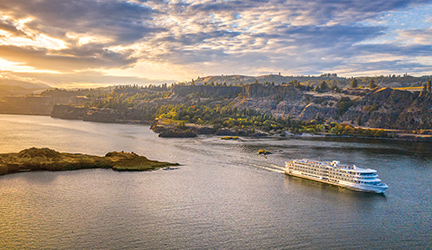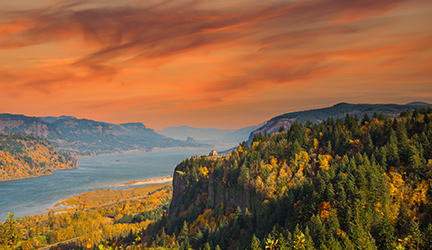Once a lifeline to the West for hopeful settlers, this 2,000-mile route shaped the future of the country and left an indelible mark on the landscape. The story of the Oregon Trail continues to capture the American imagination.
Today, travelers can experience many of the Oregon Trail’s key locations on American Cruise Lines’ Columbia & Snake River cruises. Ignite your sense of adventure on itineraries such as the Columbia & Snake Rivers cruise and the Highlights of the Columbia River cruise. Trade in a covered wagon for a luxury small ship with curated excursions that highlight the region’s dramatic history and enduring legacy.
The History of the Oregon Trail
The Oregon Trail emerged in the early 19th century as an essential route for westward expansion. Originally established by fur trappers, traders, and missionaries, the trail soon became the main artery for families seeking opportunity in the Oregon Territory.
Beginning in Independence, Missouri, and ending in Oregon City, Oregon, the trail spanned around 2,000 miles. Travelers crossed plains, rivers, deserts, and mountains, often facing treacherous conditions, illness, and uncertainty. Despite the dangers, hundreds of thousands made the journey during the mid-1800s, especially after the U.S. government encouraged migration through the Donation Land Claim Act of 1850.
Fort Dalles, now a preserved historic site in The Dalles, was a key resupply post along the route. Today, visitors can explore the original buildings and learn more about the military presence that supported the steady flow of pioneers. The route was a powerful symbol of resilience and reinvention. It represented both the promise and the peril of westward migration and continues to shape how we understand the American frontier.
What is the Oregon Trail Like Today?
While you won’t see covered wagons cresting the hills anymore, traces of the trail still exist throughout the Pacific Northwest. Much of the original route is now part of the Oregon National Historic Trail, with interpretive centers, roadside markers, and hiking trails guiding visitors through its story.
The legacy of the Oregon Trail also plays a vital role in regional identity. Towns like The Dalles and Pendleton still celebrate their roles in the story, offering historical reenactments, local museums, and community events that reflect their pioneer past.
Things To Do Along the Oregon Trail
Go to the Museums and Visitor Centers
To understand the journey west, there’s no better place to start than the many museums and visitor centers along the Columbia and Snake Rivers. Stops like the Columbia Gorge Discovery Center in The Dalles provide interactive exhibits on geology, Indigenous cultures, Lewis and Clark, and pioneer history.
Hike on the Oregon Trail
Hiking parts of the original trail today gives a powerful sense of scale and perspective. From wide, windswept plateaus to forested riverbanks, the terrain tells its own story. Many segments have been preserved as hiking routes and nature trails, allowing modern explorers to trace the same landscape pioneers crossed by foot and wagon.
If you plan to explore these areas during your cruise, be sure to review our packing guide for the Columbia & Snake Rivers, which covers everything from layered clothing to walking shoes.
Enjoy Scenic Vineyards
The pioneers weren’t stopping for wine tastings, but you can. One of the most scenic stops on the Columbia & Snake River itineraries is the Maryhill Winery Exploration & Tasting. Located on a bluff above the Columbia River, this winery offers panoramic views of the river gorge and distant Mount Hood.
During the visit, guests enjoy a curated tasting of local varietals, learn about wine production in the Pacific Northwest, and stroll the beautifully landscaped grounds. It’s a relaxing and elegant way to experience the region’s agricultural bounty.
Columbia River Gorge
This natural wonder served as both a barrier and a passage for Oregon Trail travelers. Today, the Columbia River Gorge is one of the most scenic highlights of the Pacific Northwest.
Cruising through the gorge, be awed by dramatic basalt cliffs, cascading waterfalls, and miles of mountain views. The Columbia River remains a vital waterway, with a series of locks and dams that allow for modern river navigation. Learn more about how these engineering feats work in this detailed guide to locks and dams.
Discover The Pendleton Experience
Pendleton, Oregon, is known today for its world-famous woolen mills and vibrant rodeo culture. The Pendleton Experience excursion brings visitors face to face with the city’s pioneering past.
This immersive tour includes a visit to the Pendleton Woolen Mills, where guests can see how fine wool garments are made, and a stop at the Pendleton Underground, a network of tunnels and basements once used during Prohibition and the frontier era. It’s a fascinating look at how innovation, survival, and storytelling shaped this iconic Western town.
Explore Fort Dalles
Located in The Dalles, Oregon, Fort Dalles was once one of the most important military posts in the Pacific Northwest. It served as a key resupply and protection point for emigrants during the height of Oregon Trail migration.
Visitors to the fort can tour original 1850s buildings, explore military artifacts, and gain a deeper understanding of how the army supported frontier life. Read more about the significance of this historic site in this spotlight on The Dalles port highlights.
Experience the Oregon Trail with American Cruise Lines
The Oregon Trail is more than a path through history—it is a living narrative woven through the Pacific Northwest. From historic forts and cultural centers to vineyards and river gorges, its influence can be felt at every stop along the Columbia and Snake Rivers.
Explore our Columbia & Snake River cruises and experience the Oregon Trail in a way the pioneers could never have imagined: with exceptional dining, spacious staterooms, and a front-row seat to history.


